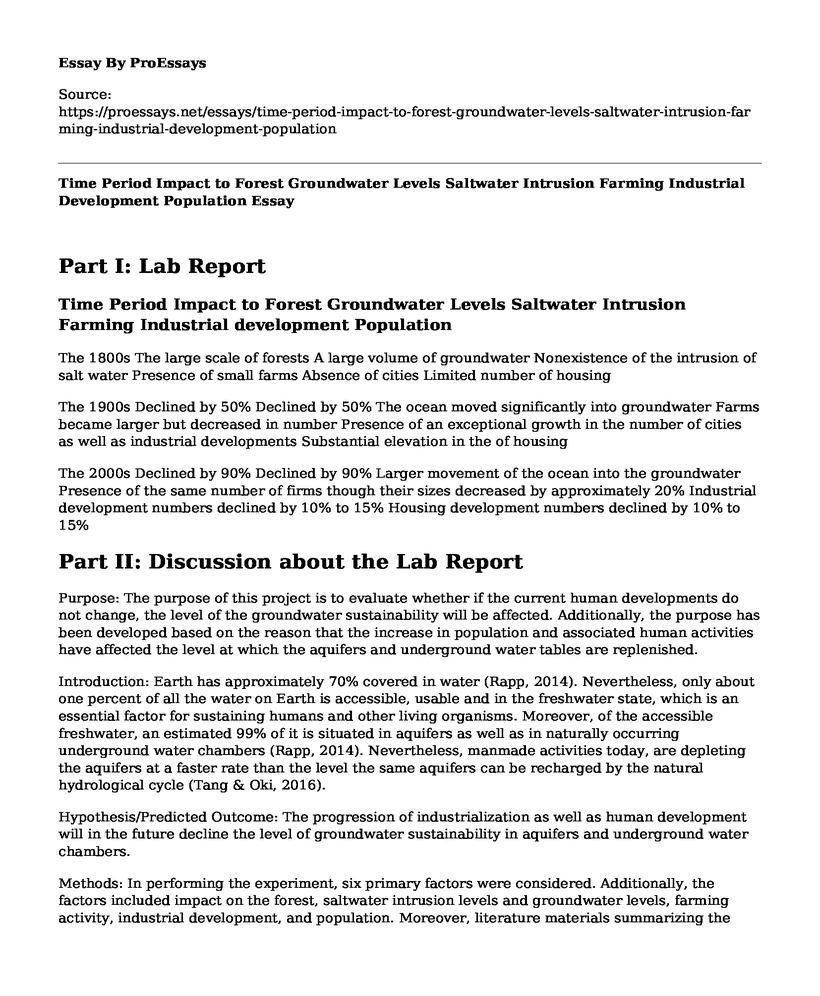Part I: Lab Report
Time Period Impact to Forest Groundwater Levels Saltwater Intrusion Farming Industrial development Population
The 1800s The large scale of forests A large volume of groundwater Nonexistence of the intrusion of salt water Presence of small farms Absence of cities Limited number of housing
The 1900s Declined by 50% Declined by 50% The ocean moved significantly into groundwater Farms became larger but decreased in number Presence of an exceptional growth in the number of cities as well as industrial developments Substantial elevation in the of housing
The 2000s Declined by 90% Declined by 90% Larger movement of the ocean into the groundwater Presence of the same number of firms though their sizes decreased by approximately 20% Industrial development numbers declined by 10% to 15% Housing development numbers declined by 10% to 15%
Part II: Discussion about the Lab Report
Purpose: The purpose of this project is to evaluate whether if the current human developments do not change, the level of the groundwater sustainability will be affected. Additionally, the purpose has been developed based on the reason that the increase in population and associated human activities have affected the level at which the aquifers and underground water tables are replenished.
Introduction: Earth has approximately 70% covered in water (Rapp, 2014). Nevertheless, only about one percent of all the water on Earth is accessible, usable and in the freshwater state, which is an essential factor for sustaining humans and other living organisms. Moreover, of the accessible freshwater, an estimated 99% of it is situated in aquifers as well as in naturally occurring underground water chambers (Rapp, 2014). Nevertheless, manmade activities today, are depleting the aquifers at a faster rate than the level the same aquifers can be recharged by the natural hydrological cycle (Tang & Oki, 2016).
Hypothesis/Predicted Outcome: The progression of industrialization as well as human development will in the future decline the level of groundwater sustainability in aquifers and underground water chambers.
Methods: In performing the experiment, six primary factors were considered. Additionally, the factors included impact on the forest, saltwater intrusion levels and groundwater levels, farming activity, industrial development, and population. Moreover, literature materials summarizing the relevant data for the six factors were obtained and recorded during the century in which they occurred. In this case, data were categorized for the time period ranging from the 1800s, 1900s as well as 2000s. Ultimately, the data collected was them summarized in the lab report featured above.
Results/Outcome: The findings of the study portrayed that there was a substantial decline in the level of groundwater on the earth surface by 2000s compared to the same levels on 1800s. Additionally, in this case, by 2000s, the level of forest cover on the earth surface had declined by 90%, which is bad since trees form part of the Earth's hydrologic cycle. Moreover, a larger level of ocean water moved into the groundwater. Ultimately, the decline in the level of sustainable freshwater aquifers caused a decline in the level of farming by 20%, reduced industrial development by 10% to 15% and ultimately, it reduced the housing development numbers by 10% to 15%.
Discussion/Analysis: From the experiment, it is evident that human activities have significantly affected the level in which aquifers and freshwater underground chambers replenish their water. As a result, seawater levels has infiltrated into the freshwater aquifers significantly reducing the level of fresh water accessible to a human for various activities. For example, in the 2000s, the level of farming and industrial revolution decreased. Subsequently, the level of human population significantly declined by 10% to 15%.
References
Rapp, D. (2014). Assessing Climate Change: Temperatures, Solar Radiation and Heat Balance. New York: Springer.
Tang, Q., & Oki, T. (2016). Terrestrial Water Cycle and Climate Change: Natural and Human-Induced Impacts. New York: John Wiley & Sons.
Cite this page
Time Period Impact to Forest Groundwater Levels Saltwater Intrusion Farming Industrial Development Population. (2022, May 26). Retrieved from https://proessays.net/essays/time-period-impact-to-forest-groundwater-levels-saltwater-intrusion-farming-industrial-development-population
If you are the original author of this essay and no longer wish to have it published on the ProEssays website, please click below to request its removal:
- Research Paper Example on Role of Women Before Civil War
- Role of Education in the 4th Industrial Revolution and Developing Nations
- Abraham Lincoln's Assassination Paper Example
- Essay Example on American Civil War: Conflict that Shaped and Preserved the Nation
- Essay on Victory at Tarin Kwot: US Army & Anti-Taliban Forces Win Great Mission
- Sara Baartman: From African Slavery to Caged Existence in Europe - Essay Sample
- Essay Example on Tata Steel: A Visionary's Journey of Nationalism & Industrial Revolution







